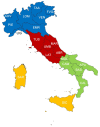Design a Database of Italian Vascular Alimurgic Flora (AlimurgITA): Preliminary Results
- PMID: 33920234
- PMCID: PMC8069721
- DOI: 10.3390/plants10040743
Design a Database of Italian Vascular Alimurgic Flora (AlimurgITA): Preliminary Results
Abstract
Despite the large number of data published in Italy on WEPs, there is no database providing a complete knowledge framework. Hence the need to design a database of the Italian alimurgic flora: AlimurgITA. Only strictly alimurgic taxa were chosen, excluding casual alien and cultivated ones. The collected data come from an archive of 358 texts (books and scientific articles) from 1918 to date, chosen with appropriate criteria. For each taxon, the part of the plant used, the method of use, the chorotype, the biological form and the regional distribution in Italy were considered. The 1103 taxa of edible flora already entered in the database equal 13.09% of Italian flora. The most widespread family is that of the Asteraceae (20.22%); the most widely used taxa are Cichorium intybus and Borago officinalis. The not homogeneous regional distribution of WEPs (maximum in the south and minimum in the north) has been interpreted. Texts published reached its peak during the 2001-2010 decade. A database for Italian WEPs is important to have a synthesis and to represent the richness and complexity of this knowledge, also in light of its potential for cultural enhancement, as well as its applications for the agri-food system.
Keywords: AlimurgITA; Italy; database; ethnobotany; wild edible plants (WEPs).
Conflict of interest statement
The authors declare no conflict of interest.
Figures


















References
-
- Arnason T., Hedba R.J., Johns T. Use of plants for food and medicine by Native Peoples of eastern Canada. Can. J. Bot. 1981;59:2189–2325. doi: 10.1139/b81-287. - DOI
-
- Gispert M., Gonzalez C. Plantas comestibles–plantas medicinales ¿matrimonio en concordia? Antropologicas. 1993;7:58–64.
-
- Etkin N. Medicinal cuisines: Diet and ethnopharmacology. Int. J. Pharm. 1996;34:313–326. doi: 10.1076/phbi.34.5.313.13246. - DOI
-
- Etkin N., Johns T. ‘Pharmafoods’ and ‘nutraceuticals’: Paradigm shifts in biotherapeutics. In: Prendergast H.D.V., Etkin N.L., Harris D.R., Houghton P.J., editors. Plants for Food and Medicine. Royal Botanic Gardens, Kew; London, UK: 1998. pp. 3–16.
LinkOut - more resources
Full Text Sources
Other Literature Sources

